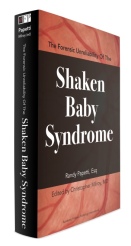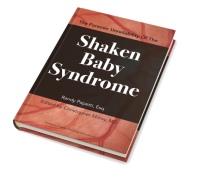Arizona trial attorney Randy Papetti has brought nearly 20 years of experience and research to his valuable new analysis of shaken baby theory in the courtroom, The Forensic Unreliability of the Shaken Baby Syndrome, now shipping from Academic Forensic Pathology International.
Papetti is not a criminal attorney but a recognized leader in his primary field, commercial litigation. In 2013, he was selected by Best Lawyers and his local peers as the Lawyer of the Year for “Bet-the-Company Litigation.” In 2011, he was inducted into the invitation-only American College of Trial Lawyers. His shaken baby work has all been pro bono.
Papetti was only doing a favor for a friend, he told me in a telephone interview, when he agreed to help with his first alleged shaking case, an appeal of a murder conviction. The convicted father had reported a fall from a high chair, but the child abuse experts had insisted that shaking must have been involved. Papetti started researching the medical and legal arguments, he said, and found himself face to face with the difference between medical opinion and proven scientific fact.
Papetti won that appeal, and other attorneys started approaching him with their own shaking cases. He was a key player in the 2012 freeing of Drayton Witt, whose son died after a short lifetime of serious health problems, including a seizure disorder. It was the Witt case that brought pioneering pediatric neurosurgeon Dr. Norman Guthkelch back into the arena, four decades after he lay the groundwork for the diagnosis by proposing that shaking an infant could cause subdural bleeding. Like Papetti, Dr. Guthkelch rejected the medical thinking that had convicted Drayton Witt. Guthkelch then spent the final years of his life fighting what he considered a “tragic misinterpretation” of his work.
“Witt was a powerful case,” Papetti said. “It showed how easily a mistaken diagnosis based on the ‘triad‘ can convict.” By then law professor Deborah Tuerkheimer had published her first journal argument against shaking theory, and her New York Times op ed. Papetti thought the tide was turning. “The information was out there, people could see that shaking theory was unreliable.”
 Instead of reconsidering their model, however, proponents of shaking theory “took a course I never imagined they would be able to take, claiming there never was a triad,” Papetti marveled in our interview. In his book, he noted that changing the name of the diagnosis from “shaken baby syndrome” to “abusive head trauma” did not address the fundamental problem that the entire theory was speculation. “It merely changed the diagnosis’ name for legal purposes.”
Instead of reconsidering their model, however, proponents of shaking theory “took a course I never imagined they would be able to take, claiming there never was a triad,” Papetti marveled in our interview. In his book, he noted that changing the name of the diagnosis from “shaken baby syndrome” to “abusive head trauma” did not address the fundamental problem that the entire theory was speculation. “It merely changed the diagnosis’ name for legal purposes.”
 Papetti said he was “stunned” to see how child abuse professionals have lashed out personally at defense experts and attorneys: ridicule at conferences, perjury charges, letters to employers. “That’s not the way the game is played,” he said. Attorneys in civil practice fight hard in the courtroom, he claimed, but can still respect their opponents professionally and maintain personal friendships.
Papetti said he was “stunned” to see how child abuse professionals have lashed out personally at defense experts and attorneys: ridicule at conferences, perjury charges, letters to employers. “That’s not the way the game is played,” he said. Attorneys in civil practice fight hard in the courtroom, he claimed, but can still respect their opponents professionally and maintain personal friendships.
In his book, Papetti traces the evolution of shaking theory in both the medical literature and the courts. He illustrates how the two have co-evolved, distorting each other, and he examines the cooperative relationship among child abuse experts, the police, and social services. He writes:
These institutional realities, not science or clinical validation, best explain how SBS has persisted and why the medical profession is unlikely to correct it any time soon.
“Things tend to get worse before they get better,” he told me, “And I’m afraid that’s where we are now, still getting worse.” At this point, proponents of shaking theory staff the medical schools and the childrens’ hospitals, dominate the professional organizations, and conduct the bulk of the research. Critics tend to be independent thinkers who have researched the literature and reached their own conclusions. “The imbalance of power has distorted everything completely,” Papetti said. “At the end of the day, are you really asking a judge to not allow the testimony of these luminaries because a few brave souls disagree?”
So he keeps chipping away at a calcified theory with the facts, hoping to explain it all clearly enough that judges will see how decades of unproven medical testimony have led to a criminal justice crisis of staggering proportions.
For postings about other books on shaken baby, please see “Flawed Convictions: Breaking Academic Ground,” “Forward, Into the Bookstores,” “An Important Story, Well Told,” and “‘Journey With Justice’: A Rough Road.”
Copyright 2018, Sue Luttner
If you are not familiar with the medical debate surrounding shaken baby syndrome, please see the home page of this blog.




Pingback: Past the Worst of Their Nightmare, and Trying to Make a Difference | On Shaken Baby
Does this book not come in paperback?
Hardcover not allowed in prisons.
Good question. I will ask.
Pingback: Dr. John Plunkett, Champion of Justice, 1947–2018 | On Shaken Baby
Pingback: Shaken baby syndrome--WTR — Court-Martial Trial Practice Blog — April 11, 2018